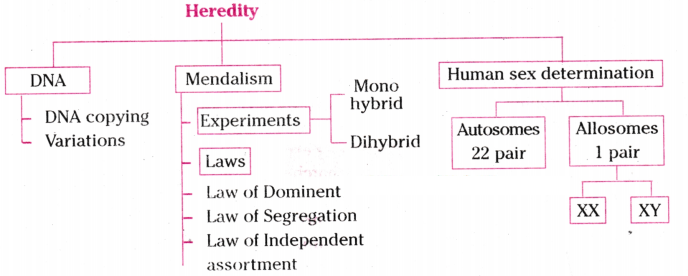AP 10th Class Biology 8th Lesson Heredity Important Questions
Class 10 Biology Chapter 8 Important Questions - 1 Mark
Question 1.
What is Gene ?
Answer:
A section of DNA that provides information for one protein is called the gene for that protein.
Question 2.
Who is considered the father of modern genetics ?
Answer:
Gregor Mendel.
Question 3.
What organism did Mendel use for his experiments in genetics ?
Answer:
Pea plants (Pisum sativum).
Question 4.
What are the alternative forms of a gene called ?
Answer:
Alleles.
Question 5.
Define the term "Dominant Allele."
Answer:
An allele that expresses its phenotype even when present in heterozygous condition.
Question 6.
What is the term for an individual with two different alleles for a particular gene?
Answer:
Heterozygous
Question 7.
Explain the law of segregation proposed by Mendel.
Answer:
During gamete formation, the two alleles for a gene segregate (separate) and end up in different gametes.
Question 8.
What is the phenotypic ratio in the F2 generation of a monohybrid cross between two heterozygous individuals ?
Answer:
3:1.
Question 9.
Define the term "genotype."
Answer:
The genetic makeup of an organism, usually represented by letters(e.g., AA, Aa, or aa).
Question 10.
in Mendel’s experiments, what ratio of phenotypes did he observe in the FI generation of a monohybrid cross
Answer:
1:0 (all are tall).
Question 11.
What is the ratio of genotypes in the F2 generation of a dihybrid cross between two individuals who are heterozygous for both traits ?
Answer:
9:3:3: 1
Question 12.
Which sex chromosome combination results in a male individual ?
Answer:
XY
Question 13.
Define Genotype.
Answer:
Genotype refers to the genetic makeup of an organism, representing the specific combination of alleles present in its DNA.
Question 14.
What is the role of DNA in genetics ?
Answer:
DNA (Deoxyribo Nucleic Acid) carries genetic information and serves as the hereditary material, encoding instructions for the development, functioning, and reproduction of living organisms.
Question 15.
What is the difference between a dominant and a recessive allele ?
Answer:
A dominant allele masks the effect of a recessive allele in a heterozygous individual. The phenotype expressed is determined by the dominant allele.
Question 16.
Define mutation.
Answer:
A mutation is a change in the DNA sequence of a gene. It can result in variations that may affect the structure or function of the encoded protein.
Question 17.
What is genetic variation ?
Answer:
Genetic variation refers to the diversity of alleles and genotypes within a population or species.
Question 18.
Explain the term "Homozygous."
Answer:
Homozygous refers to an individual having two identical alleles for a particular gene. It can be homozygous dominant (AA) or homozygous recessive (aa).
Question 19.
What is a Punnett square used for in genetics ?
Answer:
A Punnett square is a tool used to predict the possible genetic outcomes of a cross between two individuals with known genotypes.
Question 20.
Define genetic recombination.
Answer:
Genetic recombination is the rearrangement of genetic material, usually through the exchange of DNA segments between homologous chromosomes during meiosis.
Question 21.
What is a pedigree chart ?
Answer:
A pedigree chart is a diagram that shows the relationships and genetic connections among a set of individuals in a family over several generations.
Question 22.
What is the role of the Y chromosome in human sex determination ?
Answer:
The Y chromosome carries genes that determine the development of male characteristics.
Question 23.
In an experiment with pea plants, a pure tall plant (TT) is crossed with a pure short plant (tt). What will be the ratio of pure tall plant to pure short plants in F2 generation?
Answer:
1: 1
Question 24.
A cross between pea plant with white flowers (vv) and pea plant with violet flowers (VV) resulted in F2 progeny in which ratio of violet (VV) and white (vv) flowers will be
A) 1: 1
B) 2: 1
C) 3: 1
D) 1: 3
Answer:
C) 3: 1
Question 25.
The number of chromosomes in parents and offspring of a particular species undergoing sexual reproduction remain constant due to : ____________
Answer:
Halving of chromosomes at the time of gamete formation.
Question 26.
If a tall pea plant is crossed with a pure dwarf pea plant then, what percentage of F1 and F2 generation respectively will be tall?
Answer:
100 %, 75 %
Question 27.
Assertion : Height in pea plants is controlled by efficiency of enzymes and is thus genetically controlled.
Reason : Cellular DNA is the information source for making proteins in the cell.
A) Both A and R are true and R is the correct explanation of A
B) Both A and R are true and R is not the correct explanation of A
C) A is true but R is false
D) A is false but R is true
Answer:
A) Both A and R are true and R is the correct explanation of A
Question 28.
Assertion : A geneticist crossed a pea plant having violet flowers with a pea plant with white flowers, he got all violet flowers in first generation.
Reason : White colour gene is not passed on to next generation.
A) Both A and R are true and R is correct explanation of the assertion.
B) Both A and R are true but R is not the correct explanation of the assertion.
C) A is true but R is false.
D) A is false but R is true.
Answer:
A) Both A and R are true and R is correct explanation of the assertion.
Question 29.
Assertion : In humans, if gene (B) is responsible for black eyes and gene (b) is responsible for brown eyes, then the colour of eyes of the progeny having gene combination Bb, bb, or BB will be black only.
Reason : The black colour of the eyes is a dominant trait.
A) Both A and R are true and R is the correct explanation of A
B) Both A and R are true and R is not the correct explanation of A
C) A is true but R is false
D) A is false but R is true
Answer:
D) A is false but R is true
Question 30.
What are the alleles in dwarf plant ?
Answer:
tt
Question 31.
What are the alleles in tall plant ?
Answer:
TT or Tt
Question 32.
What are the alleles in homozygous tall ?
Answer:
TT
Question 33.
Draw the checker for Yy,Yy combination.
Answer:
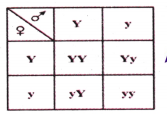
Question 34.
What is the phenotype ratio in F2 generation in the following diagram?
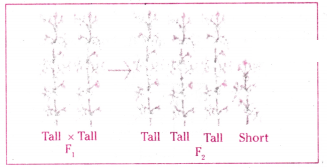
Answer:
3: 1
Question 35.
What is the use of Mendel’s life?
Answer:
Mendel’s laws help to us to understand genetic combination and their inheritance.
Question 36.
What are the uses of variations?
Answer:
- Variations enable better adaptation of an organism in changing environmental condition.
- In the case of plants and animals, they help in disease resistance.
Heredity Class 10 Important Questions - 2 Marks
Question 1.
What are the variations observed by Mendel in garden peas ?
Answer:
Mendel used a number of contrasting visible characters of garden peas - round/wrinkled seeds, tall/short plants, white/violet flowers and so on.
Question 2.
How many sets of genes present in a cell ?
Answer:
This means that each pea plant must have two sets of all genes, one inherited from each parent. For this inheritance mechanism to work, each germ cell must have only one gene set.
Question 3.
What is the Law of Segregation in Mendelian genetics ?
Answer:
The Law of Segregation states that each individual has two alleles for each gene, and these alleles segregate (separate) during the formation of gametes. As a result, each gamete carries only one allele for a particular trait.
Question 4.
Define the terms "dominant" and "recessive" in Mendelian genetics.
Answer:
In Mendelian genetics, a dominant allele is expressed phenotypically and masks the effect of a recessive allele in heterozygous individuals. The recessive allele is only expressed in the homozygous state when there are two copies present.
Question 5.
Explain the difference between genotype and phenotype.
Answer:
Genotype refers to the genetic makeup of an organism, representing the combination of alleles present for a particular trait. Phenotype, on the other hand, is the observable physical or biochemical expression of the genotype.
Question 6.
If a pea plant with the genotype Tt (where T represents tall and t represents short) is crossed with another Tt plant, what are the possible genotypes and phenotypes of their offspring ?
Answer:
The possible genotypes are TT, Tt, and tt. The corresponding phenotypes are tall (TT and Tt) and short (tt).
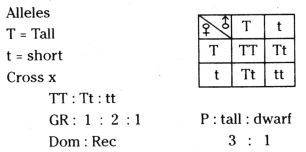
Question 7.
What is a test cross in Mendelian genetics?
Answer:
A test cross is a genetic cross between an individual with a dominant phenotype but unknown genotype (usually homozygous dominant) and an individual with a known homozygous recessive genotype. It is done to determine the genotype of the individual with the dominant phenotype.
Question 8.
How does Mendel’s Law of Independent Assortment apply to dihybrid crosses?
Answer:
Mendel’s Law of Independent Assortment states that alleles of different genes segregate independently of each other during the formation of gametes. In dihybrid crosses, this means that the inheritance of one pair of alleles for a trait does not influence the inheritance of alleles for another trait.
Question 9.
What is the role of the Y chromosome in human sex determination ?
Answer:
- Y chromosome has crucial role in human sex determination.
- Because only males have the Y chromosome, the genes on this chromosome tend to be involved in male sex determination and development.
Question 10.
How does the process of sex determination occur during fertilization ?
Answer:
The sex determination of an individual is determined by the combination of sex chromosomes inherited from both parents. If an individual inherits an X chromosome from the mother and an X chromosome from the father, it develops into a female (XX). If the individual inherits an X chromosome from the mother and a Y chromosome from the father, it develops into a male (XY).
Question 11.
How do autosomal chromosomes contribute to sex determination ?
Answer:
Autosomal chromosomes (non-sex chromosomes) carry genes that influence the development of reproductive organs. While they do not determine the sex of an individual, they play a role in the overall process of sexual development by influencing the development of secondary sexual characteristics.
Question 12.
Give the respective scientific terms used for studying :
i) The mechanism by which variations are created and inherited and
ii) The development of new type of organisms from the existing ones.
Answer:
i) Evolution is the mechanism by which variations are created and heredity is the mechanism of inheriting these variations. Heredityis the passing of traits from one generation to the next generation or from parents to the offspring,
ii) Speciation is an evolutionary process in which new organisms are created from existing ones..
Question 13.
"The chromosomes number of the sexually reproducing parents and their offspring is the same." Justify this statement.
Answer:
Gametes of sexually-reproducing animals have half the number of chromosomes as that of the parents. During fertilization, when two gametes i.e. male and female gametes, fuse, the offspring produced will have the same amount of DNA or the same number of chromosomes as that of the parent.
Question 14.
Mustard was growing in two fields. A and B. While Field A produced brown coloured seeds, field B produced yellow coloured seeds.
It was observed that in field A, the offsprings showed only the parental trait for consecutive generations, whereas in field B, majority of the offsprings showed a variation in the progeny.
What are the probable reasons for these ?
Answer:
- Variation in parental trait is possible in case of Cross Pollination and not Self Pollination.
- In field A, since offspring showed same parental trait of brown colored seeds, it is Self-Pollination.
- In field B, since offspring showed different parental trait of yellow-colored seeds, it may be case of Cross-Pollination.
Question 15.
A green stemmed tomato plant denoted by (GG) is crossed with a tomato plant with purple stem denoted by (gg).
i) What colour of the stem would you expect in their F1 progeny ?
ii) In what ratio would you find the green and purple coloured stem in plants of F2 progeny ?
iii) What conclusion can be drawn for the above observations ?
Answer:
i) When the two plants were crossed in a monohybrid cross, it resulted in the formation of F1 progeny that was green colored and the genotype is heterozygous dominant (Gg).
ii) When F1 plants are self-pollinated, then out of four plants, three plants are green stemmed (75%) whereas, one plant is purple stemmed (25%).
iii) In the F2 progeny, GG (Homozygous dominant), Gg (heterozygous dominant), and gg (homozygous recessive) were present in a ratio of 1:2:1. Ratio of GG and gg is 1:1.
Question 16.
List two differences in tabular form between dominant trait and recessive traits.
Answer:
| Dominant trait |
Recessive trait |
| 1) It is the trait that controlled by dominant allele. |
1) It is the trait controlled by recessive allele. |
| 2) It is the trait which is expressed in F1 generation. |
2) It is the trait which remains suppressed in F1 generation and appears in F2 generation. |
Question 17.
Write phenotypic ratio and Genotypic ratio of table given below :

Answer:
Phenotypic ratio is 3 : 1.
Genotypic ratio is 1 : 2 : 1.
Question 18.
Draw the checker board for TT cross with tt.
Answer:
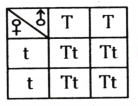
Question 19.
Draw the checker board for Tt and Tt.
Answer:
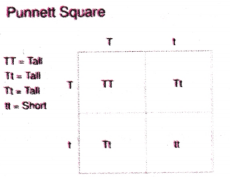
Important Questions on Heredity Class 10 - 4 Marks
Question 1.
Write about Mendel.
Answer:
Mendel was educated in a monastery and went on to study science and mathematics at the University of Vienna. Failure in the examinations for a teaching certificate did not suppress his zeal for scientific quest. He went back to his monastery and started growing peas.
Many others had studied the inheritance of traits in peas and other organisms earlier, but Mendel blended his knowledge of science and mathematics and was the first one to keep count of individuals exhibiting a particular trait in each generation. This helped him to arrive at the laws of inheritance.
Question 2.
How do proteins control the characteristics that we are discussing here?
Answer:
- Let us take the example of tallness as a characteristic. To know how do proteins control the characteristics.
- We know that plants have hormones that can trigger growth. Plant height can thus depend on the amount of a particular plant hormone.
- The amount of the plant hormone made will depend on the efficiency of the process for making it.
- Consider now an enzyme that is important for this process. If this enzyme works efficiently, a lot of hormone will be made, and the plant will be tall.
- If the gene for that enzyme has an alteration that makes the enzyme less efficient, the amount of hormone will be less, and the plant will be short.
- Thus, genes control characteristics, or traits.
Question 3.
How the inheritance process work ?
Answer:
- That each gene set is present, not as a single long thread of DNA, but as separate independent pieces, each called a chromosome.
- Thus, each cell will have two copies of each chromosome, one each from the male and femate parents.
- Every germ cell will take one chromosome from each pair and these may be of either maternal or paternal origin.
- When two germ cells combine, they will restore the normal number of chromosomes in the progeny, ensuring the stability of the DNA of the species.
Question 4.
Were the tall plants in the F1 generation exactly the same as the tall plants of the
parent generation ?
Answer:
- Tall plants in the F1 generation exactly the same as the tall plants of the parent generation where the both parents are homozygous tall.
- Generally the F1 generation plants is hybrid and looks similar to the parent plant so phenotype is the same, but the genotype of that plant will be different as it is hybrid of two different parents.
- Yes, the tall plants are exactly the same in appearance as the plants in the parent generation.
Question 5.
How do germ-cells make a single set of genes from the normal two copies that all, other cells in the body have?
Answer:
- Diploid germ cells must undergo many rounds of cell division and create many new cells in order to produce haploid gametes.
- Meiosis therefore helps the germ cells make a single set of genes (haploid) from the normal two copies (diploid).
- So to produce the gametes all gamete mother cells goes to meiosis.
Question 6.
Do all these variations in a species have equal chances of surviving in the environment in which they find themselves ?
Answer:
- Obviously not. Depending on the nature of variations, different individuals would have different kinds of advantages.
- Some time it may beneficial and help to serial.
- Sometimes those are harmful and lead to destruction.
- This process is called natural selection.
Question 7.
How is the sex of a newborn individual determined ?
Answer:
- In some animals like a few reptiles, the temperature at which fertilized eggs are kept determines whether the animals developing in the eggs will be male or female.
- In other animals, such as snails, individuals can change sex, indicating that sex is not genetically determined.
- However, in human beings, the sex of the individual is largely genetically determined.
- In other words, the genes inherited from our parents decide whether we will be boys or girls.
Question 8.
Two green plants are kept separately in oxygen free containers, one in the dark and other in sunlight. It was observed that plant kept in dark could not survive longer. Give reason for this observation.
Answer:
- Plants release carbondioxide during respiration.
- In case of plant which is being kept in dark, carbondioxide will accumulate in the container. This will finally result in lack of oxygen for the plant and plant would die.
- In case of plant which is being kept in light, carbondioxide shall be utilized during photosynthesis and Oxygen will be released.
- This will help in maintaining the availability of oxygen for respiration. As a result, the plant whjch is kept in continuous light will live longer.
Question 9.
What are chromosomes ? Explain how in sexually reproducing organisms the number of chromosomes in the progeny is maintained.
Answer:
- Chromosomes : They are the thread like structures having DNA and associated proteins, found in the nucleus at the time of cell division.
- They transfer hereditary characters to offsprings.
- Sexual reproduction includes gametogenesis via meiosis and random fertilization of male and female gametes.
- Meiosis reduces the chromosome number to half in gametes and fertilization restores the somatic chromosome number in the zygote.
Question 10.
Ramu and Ramya are newly married couple. They want to give birth to a male child.
a) Draw a probable diagram showing transfer of chromosomes from parents to give birth to male child.
b) Who determines the sex of the baby? How can you say?
Answer:
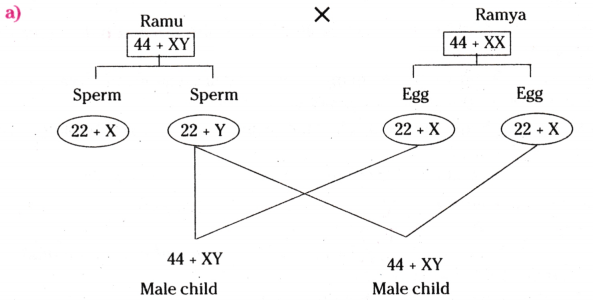
b) Father (Ramu) determines the sex of the baby. Because the chromosome ‘Y’ that determines the male sex is present in males.
Question 11.
Name the plant Mendel used for his experiment. What type of progeny was obtained by Mendel in FI and F2 generataions when he crossed the tail and short plants ? Write the ratio he obtained in F2 generation plants.
Answer:
1. Mendel selected garden pea (pisum sativum) for his series of hybridisation experiments.
2. He first selected two pure line plants (tall plant having gene TT and short plants having gene tt and then crossed such plants having contrasting characters.
3. In the F1 generation, he observed that only one of the two contrasting characters appeared, he called this character as dominant and the one which does not get expressed in F1 was called as recessive.
4. He later self pollinated the F1 plants and observed that both the traits appear in next generation but in a definite proportion. So, the plants of F1 generation will be all tall plants and after self crossing the ratio of tall and dwarf plants that Mendel obtained in F2 generation plants is 3 : 1.
Question 12.
Figures (a) to (d) given below represent the type of ear lobes present in a family consisting of 2 children - Rahul, Nisha and their parents.
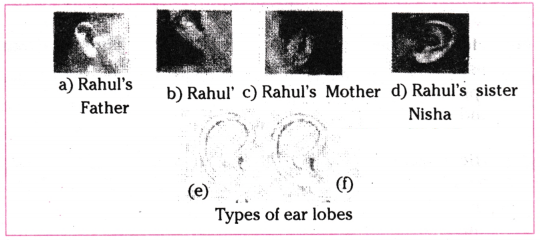
Excited by his observation of different types of ear lobes present in his family, Rahul conducted a survey of the type of ear lobes found {Figure (e) and (f)} in his classmates. He found two types of ear lobes in his classmates as per the frequency given below :
| Sex |
Free |
Attached |
| Male |
36 |
14 |
| Female |
31 |
19 |
On the basis of above data answer the following questions.
a) Which of the two characteristics - ‘free ear lobe’ or ‘attached ear lobe’ appears to be dominant in this case ? Why ?
b) Is the inheritance of the free ear lobe linked with sex of the individual ? Give reason for your answer.
c) What type of ear lobe is present in father, mother, Rahul and his sister Nisha ?
d) Write the genetic constitution of each of these family members which explains the inheritance of this character in this family ?
(Gene for Free ear lobe is represented by F and gene for attached ear lobe is represented by f for writing the genetic constitution).
Answer:
a) Free ear lobe is dominant because it is found in a large majority of the population.
b) No. It is not sex linked. As per the data of the family as well as the class, it is indicated that free ear lobe is present in males as well as in females.
c) Father - Ff (free ear lobe), Mother - Ff (free ear lobe), Rahul - ff (attached ear lobe) and Nisha - Ff (free ear lobe).
d) Suresh’s father - ff (attached ear lobe), mother - ff (attached ear lobe), Suresh - ff (attached ear lobe), Siya - ff (attached ear lobe). If both parents have recessive character, then all the children can have recessive character only.
Question 13.
Fill the given table and write the genotypic and phenotypic ratio.

Answer:

a) Phenotypic ratio -3:1
b) Genotypic ratio -1:2:1
Question 14.
Differentiate the Monohybrid Cross and Dihybrid Cross.
Answer:
| Monohybrid Cross |
Dihybrid Cross |
| 1) In monohybrid cross only one pair of contrasting characters are taken into consideration. |
1) In dihybrid cross two pairs of contrasting characters are taken into consideration. |
| 2) In monohybrid cross, the phenotype ratio of F2 generation individuals is 3 :1. |
2) In Dihybrid cross, the phenotype ratio of F2 generation individuals is 1 : 2 : 1. |
| 3) In monohybrid cross, the genotype ratio of F2 generation individuals is 1:2:1. |
3) In dihybrid cross, the genotype ratio of F2 generation individuals is 9 : 3 : 3 :1. |
Question 15.
With the help of an example, justify the following statement : "A trait may be inherited, but may not be expressed."
Answer:
- A trait may be inherited but may not be expressed, this could be explained by the given example.
- When a tall pea plant was crossed with a dwarf pea plant, then F1 generation plants were all tall.
- When F1 generation plants were self pollinated, then F2 generation plants were both tall and dwarf.
- This shows that the F1 plants had inherited both the parental traits but did not express dwarfness or recessive trait in the presence of the trait for tallness or dominant trail. This could be explained by the given cross :
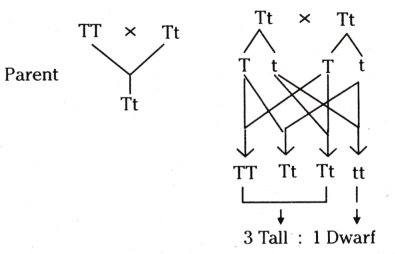
Question 16.
Observe the flow chart and answer the following questions.
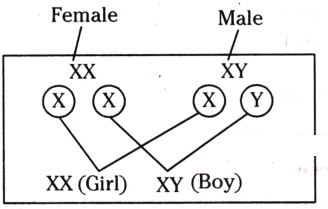
1. What are allosomes in male?
Answer: XY
2. What is the number of autosomes in men?
Answer: 44
3. What are the allosomes in female gametes?
Answer: Only X
4. What are the allosomes in male gametes?
Answer: X or Y
5. Who is responsible for baby sex determination?
Answer: Males.
Question 17.
Draw the flow chart of human sex determination.
Answer:
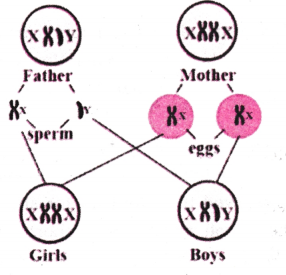
Question 18.
Write slogans about female foeticide.
Answer:
Todays girls is tomorrow’s mom
Female foeticide kills life;
Females have half of role, save them Kill the practice of female foeticide!
Female foeticide stifles life;
Female foeticide is a horrific practice; stop it!
Accept life; refuse female foeticide!
Question 19.
Females have no role in human sex determination. Comment it.
Answer:
- Human females have 22 pairs of autosomes and contain only the X sex chromosome.
- The sex of an individual is determined by the type of the male gamete (X or Y), which fuses with the X chromosome of the female.
- So, females does not have any role in sex determination of the baby.
- It’s not justice to scroll the womens while birth of girl.
Extra Questions on Heredity Class 10 - 8 Marks
Question 1.
Write about Mendel monohybrid experiment ?
Answer:
Mendel, an Austrian scientist, is often referred to as the father of modern genetics. He conducted experiments with pea plants and established the basic laws of inheritance. In a mono-hybrid experiment, Mendel focused on a single trait (mono = one) and studied how it was inherited from one generation to the next. Let’s take an example using Mendel’s pea plant experiments :
Trait Selection : Mendel selected a trait with two distinct forms, such as tall and short plants. He choose traits that were easy to observe and had clear variations.
Parental Cross (P Generation) : Mendel crossed two pure breed plants with contrasting traits, for example, a tall plant (TT) and a short plant (tt). This is known as the parental generation (P generation).
First Filial Generation (FI Generation) : The offspring of the P generation are called the first filial generation (F1). In this case, all the plants in the F1 generation were tall. Mendel observed that the trait for tallness seemed to dominate over the trait for shortness.
Self-Fertilization (F1 Generation) : Mendel allowed the tall plants in the F1 generation to self-fertilize. This resulted in the second filial generation (F2). Observations of F2 Generation: In the F2 generation, Mendel observed that the trait for shortness reappeared. Approximately 75% of the plants were tall, and 25% were short. This 3:1 ratio of tall to short plants became one of the key ratios in Mendel’s laws of inheritance.
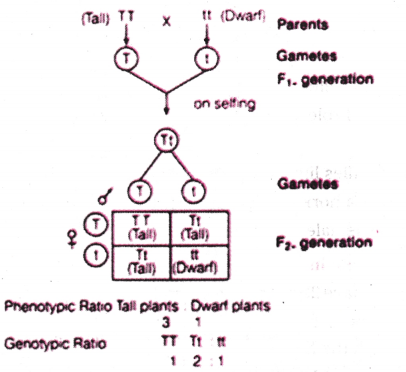
Question 2.
Explain the Mendel’s law of dominance with suitable examples.
Answer:
Mendel’s Law of Dominance is one of the fundamental principles in classical genetics proposed by Gregor Mendel, an Austrian scientist, in the mid-19th century.
This law states that, in a pair of contrasting traits (alleles) for a particular characteristic, one allele will be dominant over the other, and the dominant allele will be expressed in the phenotype of the organism.
Example: Consider Mendel’s experiments with pea plants and the trait of flower colour. Let’s use the allele for purple flowers (P) as dominant and the allele for white flowers (p) as recessive.
Parental Generation (P) : Mendel crossed pure breed purple-flowered plants (PP) with purebreed white-flowered plants (pp).
First Filial Generation (F1) : The offspring all had purple flowers. This is because the dominant allele (P) masks the expression of the recessive allele (p). So, all plants in the F1 generation were heterozygous (Pp).
Second Filial Generation (F2) : When Mendel crossed the plants from the F1 generation (Pp), he found that the purple-flowered trait reappeared in approximately a 3:1 ratio. Three plants had purple flowers (PP or Pp), and one plant had white flowers (pp). This 3 : 1 ratio in the F2 generation supports Mendel’s Law of Dominance.
Question 3.
Write about Mendel’s dihybrid experiment.
Answer:
- In a dihybrid cross, Mendel took a pair of contradicting traits together for crossing; for example color and the shape of seeds at a time.
- He picked the wrinkled-green seed and round-yellow seed and crossed them.
- He obtained only round-yellow seeds in the F1 generation. This indicated that round shape and yellow color of seeds are dominant in nature While the wrinkled shape and green color of seeds are recessive traits.
- Then, F1 progeny was self-pollinated. This resulted in four different combinations of seeds in F2 generation. They were wrinkled-yellow, round-yellow, wrinkled-green seeds and round-green in the phenotypic ratio of 9 : 3 : 3 : 1.
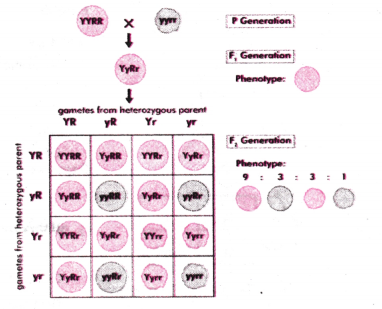
Question 4.
Write the difference between homozygous and heterozygous.
Answer:
| Characteristic |
Homozygous |
Heterozygous |
| Definition |
Both alleles for a gene are identical |
Alleles for a gene are different |
| Alleles |
AA (for a specific gene) |
Aa (for a specific gene) |
| Genotype |
Homozygous dominant (e.g., AA) |
Heterozygous (e.g., Aa) |
| Phenotype |
Expression of dominant trait |
Expression of dominant trait |
| Genetic makeup |
Homogeneous |
Heterogeneous |
| Examples |
TT (homozygous dominant) |
Tt (heterozygous) |
Question 5.
Write difference between F1 and F2 generations.
Answer:
| Characteristic |
F1 Generation |
F2 Generation |
| Definition |
Offspring resulting from the cross of two pure-breeding individuals (P generation). |
Offspring resulting from the cross of F1 individuals. |
| Genetic Makeup |
Heterozygous (having two different alleles for a particular trait). |
Genotypic ratio of 1 : 2 : 1 for homozygous dominant: heterozygous; homozygous recessive. |
Phenotypic
Expression |
Usually displays the dominant trait. |
Phenotypic ratio of 3 : 1 for dominant; recessive traits. |
| Genetic Variation |
Limited due to the uniform genetic makeup of the parents. |
Increased genetic variation due to recombination in the F1 generation. |
| Example |
If purebreed tall (TT) is crossed with purebreed short (tt), the F1 generation will be all heterozygous tall (Tt). |
If two F1 individuals (Tt) are crossed, the F2 generation will have a genotypic ratio of 1 TT: 2 Tt: 1 tt. |
Question 6.
Write the sex determination process in human being. (OR)
There is no role of female in human sex determination. Explain it. (OR)
A mother in law scolded the daughter in law because of having a female child. How can you support the daughter in law ?
Answer:
- In the human being, the chromosomal mechanism of sex determination is of XX-XY type.
- In humans the nucleus of each cell contains 46 chromosomes or 23 pairs of chromosomes of body characters known as autosomes, and 1 pair is of sex chromosomes known as allosomes.
- In the female, two homomorphic sex chromosomes are XX.
- In the male, two heteromorphic sex chromosomes are XY.
- The genotypes of female and male is
Female : 46 Chromosomes = 44 Autosomes + XX sex chromosomes Male : 46 Chromosomes = 44 Autosomes + XY sex chromosomes
- If the sperm that has X chromosome fuse with ovum, the zygote have XX chromosomes. It means the baby is female.
- If the sperm that has Y chromosome fuse with ovum, the zygote have XY chromosomes. It means the baby is male.
- So the sex of baby is determined by the sperm that fuse with ovum.
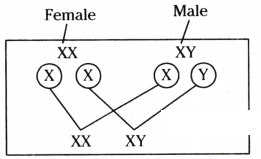
Question 7.
How does the mechanism of heredity work ?
Answer:
Heredity is the transfer of characters and genes from one generation to the next generation.
The mechanism of heredity work in the following ways :
- Characters are transferred from parent to offsprings in the form DNA.
- DNA is the basic unit of inheritance, during reproduction this DNA copies itself in the offspring, it’s similar to the main DNA, similar because there may be some errors too.
- Moreover in Sexual reproduction the DNA of both parents work inheriting the characters of both parents.
- It also helps in providing such offsprings which are similar to the parents.
- Traits are expressed in the form of genotype and phenotypes. Proteins are responsible for traits.
- Genotype is the internal genetic constitution of a particular trait. Phenotype is the physical character that is expressed in the form of a trait.
Question 8.
How do proteins control the characteristics that we are discussing here ?
Answer:
- Let us take the example of tallness as a characteristic to understand how proteins control the characteristics.
- We know that plants have hormones that can trigger growth. Plant height can thus depend on the amount of a particular plant hormone.
- The amount of the plant hormone made will depend on the efficiency of the process for making it.
- Consider now an enzyme that is important for this process.
- If this enzyme works efficiently, a lot of hormone will be made, and the plant will be tall.
- If the gene for that enzyme has an alteration that makes the enzyme less efficient, the amount of hormone will be less, and the plant will be short. Thus, genes control characteristics, or traits.
Question 9.
What happens when pea plants showing two different characteristics, rather than just one, are bred with each other ?
Answer:
This leads to the conclusion of the law of independent assortment. According to this law when two characters are taken into consideration for a cross which is called a dihybrid cross each one of these characters is independent to pass in the subsequent generation.
For example when we cross between the pea plant has round yellow seeds(RR YY) with wrinkled green (rr yy) seeds plant.
1. All plants of first generation (FI) are round and yellow with heterozygous condition
(Rr Yy)
2. In F2 generation the phenotype ratio is 9 : 3 : 3 : 1
Round yellow: 9
Round green: 3
Yellow round : 3
Green wrinkled : 1
Question 10.
What do the progeny of a tall plant with round seeds and a short plant with wrinkled- seeds look like ?
Answer:
The progeny of a tall plant with round seed (TTRR) and a short plant with wrinkled seed (ttrr) would be
1. Tall plant with round seeds (TtRr) and thus will appear same as the allele for tall plant and round seeds are dominant over the alleles for short plants with wrinkled seeds.
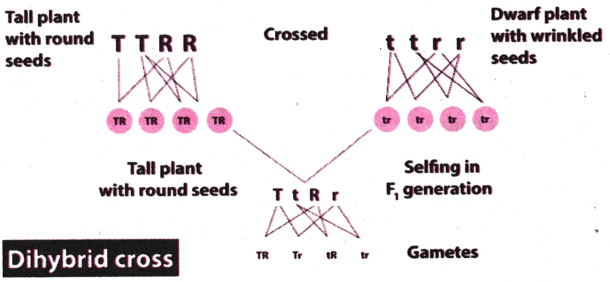
Question 11.
How can genetic inheritance determine sex ?
Answer:
- We have 23 pairs of chromosome but one pair, called the sex chromosomes, is odd in not always being a perfect pair.
- Women have a perfect pair of sex chromosomes, both called X.
- But men have a mismatched pair in which one is a normal-sized X while the other is a short one called Y.
- So women are XX, while men are XY.
- All children will inherit an X chromosome from their mother regardless of whether they are boys or girls.
- Thus, the sex of the children will be determined by what they inherit from their father.
- A child who inherits an X chromosome from her father will be a girl.
- And one who inherits a Y chromosome from him will be a boy.
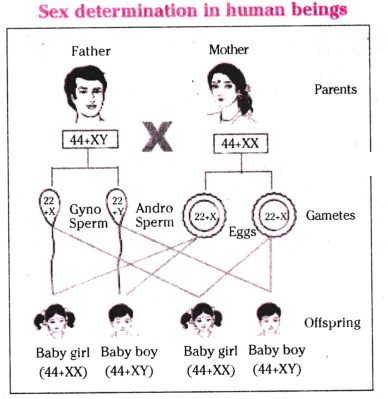
Question 12.
A green stemmed rose plant denoted by GG and a brown stemmed rose plant denoted by gg are allowed to undergo a cross with each other.
a) List your observations regarding
i) Colour of stem in their F1 progeny
ii) Percentage of brown stemmed plants in F2 progeny if F1 plants are self pollinated.
iii) Ratio of GG and Gg in the F2 progency.
b) Based on the findings of this cross, what conclusion can be drawn ?
Answer:
a) i) Colour of stem in F1 progeny:

The colour in the F1 progeny is green stemmed as green stem colour is dominant.
ii) F1 progeny on self pollination :
Gg x Gg
F2 generation Gg - Green stemmed : gg - Brown stemmed.
1/4 or 25% of F2 progeny are brown stemmed rose plants,
iii) Ratio of GG and Gg in F2 progeny : Genotype of F2 progeny - GG : Gg = 1 : 2
b) This is a monohybrid cross. This shows that out of two contrasting traits only one dominant trait appears in F1 generation and the train which does not express is recessive. On self crossing the F1 plants, both the traits appear in next generation but in a definite proportion.
Question 13.
A cross was made between pure breeding pea plants, one with round and green seeds and the other with wrinkled and yellow seeds.
a) Write the phenotype of F1 progeny. Give reason for your answer.
b) Write the different types of F2 progeny obtained along with their ratio when F1 progeny was selfed.
Answer:
a)
1. The given cross was made between pure breeding pea plants, one with round and green seeds and the other with wrinkled and yellow seeds.
2. Yellow seed colour and round seed shape is dominant over green seed colour and wrinkled seed shape.
3. In F1 generation, dominant traits express itself, whereas recessive traits get

Therefore the phenotype of F1 progeny is round and yellow,
b) The different types of F2 progeny obtained along with their ratio when F1 progeny was self pollinated could be illustrated by the given flow chart.
Phenotypic ratio is 9 : 3 : 3 : 1.
Question 14.
List in tabular form, two distinguishing features between the acquired traits and the inherited traits with one example of each.
Answer:
| Acquired trait |
Inherited trait |
| 1. The traits which are developed in response to the environment are acquired traits. |
1. A trait which is caused by changes in genes is an inherited trait. |
| 2. They cannot be inherited or passed down to future generations. |
2. They are genetic so are passed on to next generations. |
| 3. When a tail of a mouse is cut, the trait remains with the mouse; it does not get passed on to the next generation. |
3. The beatles have red and black colours. This colour dominance will select the gene to be passed on to the next generation hence the colour next progeny gets will be genetical. |
Question 15.
After self-pollination in pea plants with round, yellow seeds, following types of seeds
| Seeds |
Number |
| Round, yellow |
630 |
| Round, green |
216 |
| Wrinkled, yellow |
202 |
| Wrinkled, green |
64 |
Analyse the result and describe the mechanism of inheritance which explains these results.
Answer:
- The ratio obtained is 9:3:3:1 in which the parental as well as new combinations, can be seen.
- This shows that progeny plants did not inherited a single complete gene set from each parent.
- Every germ cell takes one chromosome from the pair of maternal and paternal chromosomes.
- When two germ cells combine, the segregation of one pair of characters is independent of another pair of characters.
- Mendel picked the wrinkled-green seed and round-yellow seed, a pair of contradicting traits and crossed them.
- He obtained only round yellow seeds in the F1 generation. This indicated that round shape and yellow color of seeds are dominant in nature. While the wrinkled 3hape and green color of seeds are recessive traits.
- Then, progeny was self-pollinated. This resulted in four different combinations of seeds in F2 generation.
Question 16.
Two pea plants - one with round yellow seeds (RRYY) and another with wrinkled green (rryy) seeds produce F1 progeny that have round, yellow (RrYy) seeds. When F1 plants are self-pollinated, which new combination of characters is expected in F2 progeny ? How many seeds with these new combinations of characters will be produced when a total 160 seeds are produced in F2 generation ? Explain with reason.
Answer:
1. F1 plants (RrYy) are self-pollinated, the possible combinations of alleles segregating during gamete formation can be determined using the principles of Mendelian genetics.
2. Segregation of alleles during the formation of gametes and results in subsequent combination during fertilization.
3. The possible combinations of alleles in the F, generation can be obtained through the multiplication of the individual allele combinations for each gene.
4. The alleles segregate independently during gamete formation, following Mendel’s law of independent assortment.
5. If you cross F1 progeny of RrYy x RrYy, you get a 9 : 3 : 3 :1 ratio for the phenotypes.
6. This is based on the fact that each gene segregates independently, and the combination of alleles for one gene does not influence the combination for the other gene.
7. If a total of 160 seeds are produced in the F2 generation, the number of seeds for each phenotype by multiplying the ratio by the total number of seeds :
- Round Yellow : 9/16 x 160 = 90 seeds
- Round Green : 3/16 x 160 = 30 seeds
- Wrinkled Yellow : 3/16 x 160 = 30 seeds
- Wrinkled Green : 1/16 x 160 = 10 seeds
Question 17.
Name the phenomenon that governs the following :
i) Green beetles living in green bushes are not eaten by the crows.
ii) Number of blue beetles in green bushes increases, only because the red beetles living there were trampled by a herd of elephants.
iii) No ‘medium height plants’ are obtained in F1 generation, upon crossing pure tall and dwarf pea plants.
iv) Tails of mice were surgically removed for several generations; still mice had tails in the following generations.
v) A migrant beetle reproduces with the local population: as a result genes of migrant beetle entefc the new population.
Answer:
i) Natural Selection :
- It is the process of evolution of a species where characteristics which help individual organisms to survive and reproduce are passed on to their offspring, and those characteristics which do not are not passed on.
- The green beetles camouflage on the green leaves and cannot be seen by crows, and hence they are not eaten by crows. Whereas, the population of red beetles is continuously declining.
ii) Genetic Drift:
- Drastic changes in the frequencies of genes in a small population is called genetic drift.
- The elephant stamp ingeradicates the red beetle population leaving only the blue beetle population. Even though the blue colof has no survival advantage, this accident in a tiny population caused a variance in the frequency of particular genes.
iii) Law of Dominance :
- The law of dominance of traits states that "When parents having pure contrasting characters are crossed, then only one character expresses itself in F1 generation. This character is the dominant character and the character which cannot express itself is called a recessive character".
- When pure tall (TT) pea plants are crossed with pure dwarf (tt) pea plants, all the plants in the F1 progeny are tall (Tt).The appearance of all tall plants in the F1 generation shows that tallness is the dominant character while dwarfness is the recessive character.
iv) Acquired traits are not inherited :
- Acquired traits are the traits a person develops during his lifetime and they aren’t passed from one generation to the next.
- Surgical removal of the tails of mice does not affect the germ cells of the mice. Only if there is a change in the germ cell, the trait will be passed onto the next generation.
v) Gene flow:
- Gene flow is the transfer of genes from one population species to another. Gene flow occurs when the transfer of genes is followed by interbreeding.
- When migrant beetles reproduce with local beetles, there is a transfer of genes and interbreeding taking place.
Question 18.
Mendel blended his knowledge of Science and mathematics to keep the count of the individuals exhibiting a particular trait in each generation. He observed a number of contrasting visible characters controlled in pea plants in a field. He conducted many experiments to arrive at the laws of inheritance.
a) If only one pair of contrasting characters like tall and short plants is taken, plants obtained in F1 generation are not of medium height. Why ?
b) Name the recessive traits in above case.
c) Mention the type of the new combinations of plants obtained in F2 progeny along with their ratio, if F1 progeny was allowed to self pollinate.
d) If 1600 plants were obtained in F2 progeny, write the number of plants having traits:
i) Tall with round seeds
ii) Short with wrinkled seeds
Write the conclusion of the above experiment.
Answer:
a) Mendel’s law of dominance states that, "When parents with pure, contrasting’traits are crossed together, only one form of trait appears in the next generation. The hybrid offsprings will exhibit only the dominant trait in the phenotype." Thus, if only one pair of contrasting charactersis taken into consideration, only the dominant trait will be expressed in F1 generation.
b) The recessive trait will be "Dwarf", which is not expressed in F1
c)
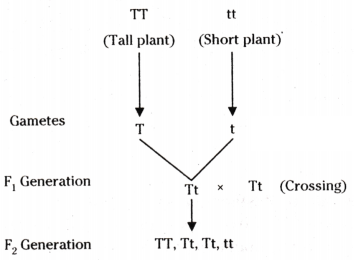
Phenotypic ratio observed in the F2 generation is 3 : 1.
d) If 1600 plants were obtained in F2 progeny, the number of plants having traits will be:
- Tall plants with round seeds = 9/16×1600 = 900
- Short plants with wrinkled seeds =1/16×1600 = 100
The experiment proves the "Law of independent assortment". This law states that the alleles of two or more different genes get sorted into gametes independently of one another.
Question 19.
Pooja has green eyes while her parents and brother have black eyes. Pooja’s husband Ravi has black eyes while his mother has green eyes and father has black eyes.
a) On the basis of the above given information, is the green eye colour a dominant or recessive trait. Justify your answer.
b) What is the possible genetic makeup of Pooja’s brother’s eye colour ?
c) What is the probability that the off spring of Pooja and Ravi will have green eyes? Also, show the inheritance of eye colour in the offspring with the help of a suitable cross.
d) 50% of the offspring of Pooja’s brother are green eyed. With help of cross show how this is possible.
Answer:
a)
- The green eye colour is a recessive trait.
- According to the given data, in pooja’s parents one parent is with green eye colour and another is with black eye colour.
- The majority of the children of Pooja’s parents have black eyes.
- Dominant traits are traits that will dominate the effect of the other allele while recessive traits need both alleles to be show up in a person.
b) The possible genetic makeup of Pooja’s brother could be one allele of black eyes (dominant) and one of the green eyes (recessive)
c) i) Ravi has black eyes represented as Bb and Pooja has green eyes represented as bb.

ii) Bb and bb are the possibilities of eye colour inherited from the parents.
iii) Therefore the probability of 50% of children to have black eyes and 50% of children to have green eyes.
d) Poojas brother has one dominant allele of black eye (B) and a recessive allele for green eye (b) As 50% of his offsprings are green eyed, his wife should have green eyes with double recessive alleles (bb).

Question 20.
All human chromosomes are not paired. Most human chromosomes have a maternal and a paternal copy, and we have 22 such pairs. But one pair called the sex chromosomes, is odd in not always being a perfect pair. Women have a perfect pair of sex chromosomes. But men have a mismatched pair in which one is normal sized while the other is a short one.
a) In humans, how many chromosomes are present in a Zygote and in each gamete?
b) A few reptiles rely entirely on environmental cues for sex determination. Comment.
c) "The sex of a child is a matter of chance and none of the parents are considered to be responsible for it." Justify it through flow chart only.
d) Why do all the gametes formed in human females have an X chromosome ?
Answer:
a) Haplotype cells make up gametes. Only 23 chromosomes are present in each egg and sperm cell, which is a fraction of a cell’s chromosomal number. A diploid cell is created when two haploid cells fuse together. Zygote is a diploid cell, which means it has 46 chromosomes.
b) Few reptiles completely rely on environmental cues for sex determination. The temperature at which fertilised eggs are stored determines whether the developing animal in the egg is male or female in some reptiles like the Lizards. Individuals in some species, such as the snail, can change sex in response to stress and environmental factors.
c) The sex of a newborn child is purely and completely a matter of chance and none of the parent i.e. mother and father may be considered answerable for it. The statement in question is justified and can be proved by the process of fertilization.
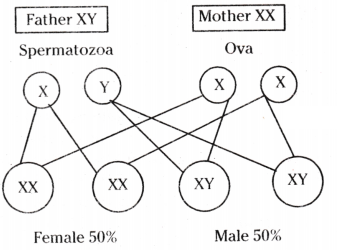
d) The female human is homomorphic. They have identical copies of both sex chromosomes. Each gamete in meiosis receives one X chromosome at the time of gamete creation. Thus, the X chromosome is present in all gametes.
Conceptual Map
